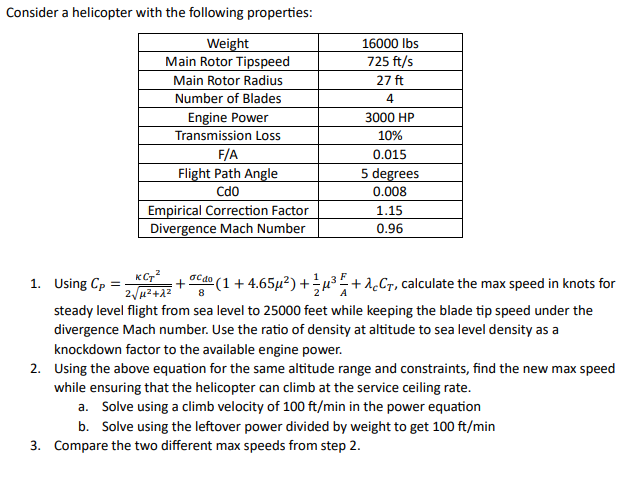Consider a helicopter with the following properties: 1. Using Cp Weight Main Rotor Tipspeed Main Rotor Radius Number of Blades Engine Power Transmission Loss F/A Flight Path Angle CdO Empirical Correction Factor Divergence Mach Number KCT2 σcdo 2√12+22 8 16000 lbs 725 ft/s 27 ft 4 3000 HP 10% 0.015 5 degrees 0.008 1.15 0.96 + ººº (1 + 4.65µ²) +¾½µ³ ²+λCT, calculate the max speed in knots for steady level flight from sea level to 25000 feet while keeping the blade tip speed under the divergence Mach number. Use the ratio of density at altitude to sea level density as a knockdown factor to the available engine power. 2. Using the above equation for the same altitude range and constraints, find the new max speed while ensuring that the helicopter can climb at the service ceiling rate. a. Solve using a climb velocity of 100 ft/min in the power equation b. Solve using the leftover power divided by weight to get 100 ft/min 3. Compare the two different max speeds from step 2.
Consider a helicopter with the following properties: 1. Using Cp Weight Main Rotor Tipspeed Main Rotor Radius Number of Blades Engine Power Transmission Loss F/A Flight Path Angle CdO Empirical Correction Factor Divergence Mach Number KCT2 σcdo 2√12+22 8 16000 lbs 725 ft/s 27 ft 4 3000 HP 10% 0.015 5 degrees 0.008 1.15 0.96 + ººº (1 + 4.65µ²) +¾½µ³ ²+λCT, calculate the max speed in knots for steady level flight from sea level to 25000 feet while keeping the blade tip speed under the divergence Mach number. Use the ratio of density at altitude to sea level density as a knockdown factor to the available engine power. 2. Using the above equation for the same altitude range and constraints, find the new max speed while ensuring that the helicopter can climb at the service ceiling rate. a. Solve using a climb velocity of 100 ft/min in the power equation b. Solve using the leftover power divided by weight to get 100 ft/min 3. Compare the two different max speeds from step 2.
Elements Of Electromagnetics
7th Edition
ISBN:9780190698614
Author:Sadiku, Matthew N. O.
Publisher:Sadiku, Matthew N. O.
ChapterMA: Math Assessment
Section: Chapter Questions
Problem 1.1MA
Related questions
Question
Recall that power available at altitude is (rho/rho0)*power at sea level. Include transmission losses!
[~, a, ~, RHO, ~] = atmosisa(alt(k1)*0.3048);
rho=RHO*0.0685218/35.3147;
rho_scale=rho/rho0;
a=a/0.3048;

Transcribed Image Text:Consider a helicopter with the following properties:
1. Using Cp
Weight
Main Rotor Tipspeed
Main Rotor Radius
Number of Blades
Engine Power
Transmission Loss
F/A
Flight Path Angle
CdO
Empirical Correction Factor
Divergence Mach Number
KCT2 σcdo
2√12+22 8
16000 lbs
725 ft/s
27 ft
4
3000 HP
10%
0.015
5 degrees
0.008
1.15
0.96
+ ººº (1 + 4.65µ²) +¾½µ³ ²+λCT, calculate the max speed in knots for
steady level flight from sea level to 25000 feet while keeping the blade tip speed under the
divergence Mach number. Use the ratio of density at altitude to sea level density as a
knockdown factor to the available engine power.
2. Using the above equation for the same altitude range and constraints, find the new max speed
while ensuring that the helicopter can climb at the service ceiling rate.
a. Solve using a climb velocity of 100 ft/min in the power equation
b. Solve using the leftover power divided by weight to get 100 ft/min
3. Compare the two different max speeds from step 2.
Expert Solution
This question has been solved!
Explore an expertly crafted, step-by-step solution for a thorough understanding of key concepts.
This is a popular solution!
Trending now
This is a popular solution!
Step by step
Solved in 2 steps

Recommended textbooks for you

Elements Of Electromagnetics
Mechanical Engineering
ISBN:
9780190698614
Author:
Sadiku, Matthew N. O.
Publisher:
Oxford University Press

Mechanics of Materials (10th Edition)
Mechanical Engineering
ISBN:
9780134319650
Author:
Russell C. Hibbeler
Publisher:
PEARSON

Thermodynamics: An Engineering Approach
Mechanical Engineering
ISBN:
9781259822674
Author:
Yunus A. Cengel Dr., Michael A. Boles
Publisher:
McGraw-Hill Education

Elements Of Electromagnetics
Mechanical Engineering
ISBN:
9780190698614
Author:
Sadiku, Matthew N. O.
Publisher:
Oxford University Press

Mechanics of Materials (10th Edition)
Mechanical Engineering
ISBN:
9780134319650
Author:
Russell C. Hibbeler
Publisher:
PEARSON

Thermodynamics: An Engineering Approach
Mechanical Engineering
ISBN:
9781259822674
Author:
Yunus A. Cengel Dr., Michael A. Boles
Publisher:
McGraw-Hill Education

Control Systems Engineering
Mechanical Engineering
ISBN:
9781118170519
Author:
Norman S. Nise
Publisher:
WILEY

Mechanics of Materials (MindTap Course List)
Mechanical Engineering
ISBN:
9781337093347
Author:
Barry J. Goodno, James M. Gere
Publisher:
Cengage Learning

Engineering Mechanics: Statics
Mechanical Engineering
ISBN:
9781118807330
Author:
James L. Meriam, L. G. Kraige, J. N. Bolton
Publisher:
WILEY